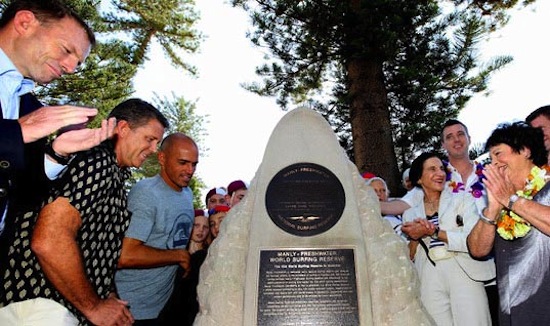Imagine the world without a Jefferys Bay, Bells Beach, Pipeline or Uluwatu?
A horrible thought, but do not fear as a global initiative is here. It’s called the World Surfing Reserves (WSR) and today Kelly Slater launched Australia’s first World Surfing Reserve.
The new reserve covers a four-kilometre (2.5 mile) stretch of coastline encompassing the Manly and Freshwater areas. Manly is considered by many the birthplace of Australian surfing. It was on Freshwater Beach in 1914 that legendary Hawaiian surfer and Olympian Duke Kahanamoku first demonstrated surfing to the Aussies.
The new Manly reserve is only the third surfing reserve in the world, the other two are in Ericiera, Portugal and Malibu, California. A fourth reserve – Santa Cruz, California will be dedicated on 28th April.
World Surfing Reserves (WSR)
Drew Kampion from the WSR Executive Committee says “World Surfing Reserves is about surfers saving the world, one wave at a time”.
The WSR is a collaborative initiative founded in 2009 by Save The Waves Coalition and the National Surfing Reserves Australia.
The goal of the World Surfing Reserves initiative is to identify areas with outstanding waves and surfing environments, and protect them.
World Surfing Reserve eligibility
Waves and surf areas are judged and selected using the following criteria:
• Quality and consistency of the wave
• Environmental characteristics of the area
• Surf culture and history of the area
• Local community support.
How does it work
The WSR program includes four stages:
1. Nomination – a location needs to be nominated by a local community group
2. Selection – the nominated sites are evaluated by a global body of experts
3. Enshrinement – if approved sites are officially enshrined as World Surfing Reserves
4. Management – includes the implementation of a WSR Management Plan by the LSC and local community
WSR mission
World Surfing Reserves, in partnership with local communities, unites the global surf community to protect the world’s sacred surf spots and in turn inspires local communities to continue to protect their own cherished waves.
Extinct waves
Do our waves really need protecting? Hell yeah!
Many waves have already been wiped out forever.
Here are just a few who rest in peace (or pollution).
Copacabana, Brazil
Died: late 1960s
Cause of death: Government road widening project
Killer Dana, California
Died: August 29, 1966
Cause of death: Army Corps of Engineers built a harbour.
La Barre, France
Died: early 1970s
Cause of death: Jetty built
Harry’s, Baja, Mexico
Died: 2005
Cause of death: natural gas terminal built by Sempra Shell LNG, defying legal injunction.
If you want to help protect our world class waves or you want to nominate a stretch of coast as a World Surfing Reserve, visit the World Surfing Reserves website.
Should Newquay, Thurso, Freshwater West or somewhere near you be a World Surfing Reserve?
